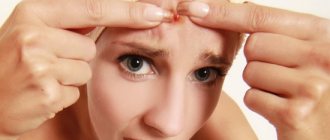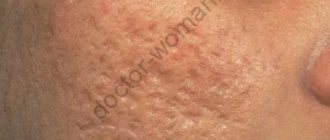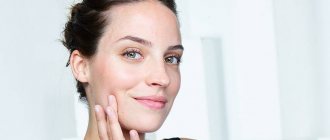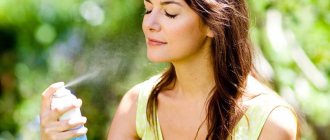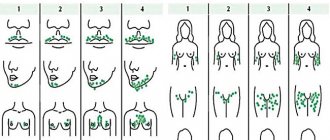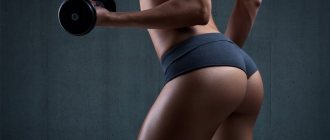What are pimples (acne)?
Acne is a chronic inflammatory disease of the sebaceous hair follicles, characterized by hyperactivity of the sebaceous glands and clogging of pores with excess sebum and other impurities.
A blackhead or blackhead is a plug made of a mixture of sebum, sweat, dead skin cells of the epidermis and external environmental pollutants, clogging the sebaceous gland and its ducts.
Sebum oxidizes upon contact with oxygen and acquires a characteristic dark shade - hence the name “blackheads”. This plug creates an airless environment favorable for the growth of acne bacteria (Propionibacterium acnes or Malassezia), which cause acne relapses.
Main types of rashes on the face
There are several types and symptoms of acne:
- Open comedones
are dense, superficial rashes, usually gray or black in color. This type of acne can be easily removed with facial cleansing. - Closed comedones (subcutaneous pimples)
are white subcutaneous rashes, the mechanism of which is similar to the appearance of open acne. Closed comedones often turn into classic red pimples: accumulated sebum has no way out and leads to painful inflammation. - Papules
are dense red pimples without purulent contents. - Pustules
are classic pimples with purulent content and a red, inflamed head, often leaving behind a stagnant spot. - Nodules (nodules)
are deep subcutaneous compactions, usually accompanied by the discharge of pus and leave behind scars. - Pink (red) pimples
are signs of rosacea and do not depend on the functioning of the sebaceous glands.
Causes of acne on the face
The appearance of acne in adults is most often associated with hyperandrogenism or increased sensitivity of the sebaceous glands to increased synthesis and activity of male sex hormones. According to dermatologists, 23% of women of fertile age and 8% of teenage girls experience hyperandrogenism. Let's look at other possible factors and causes of acne on the face.
- Hormonal imbalance
Most often, the appearance of acne is associated with changes in the hormonal system. Such changes occur during puberty, pregnancy, or during certain phases of the cycle. When an excess of male sex hormones appears in the body, the sebaceous glands actively produce sebum. Excess sebum, in turn, leads to the development of rashes at different ages. - Heredity
Physiological characteristics in the hormonal background can be inherited from parents. If one of the parents had a tendency to develop acne in childhood, then there is a high probability that the child will similarly face the same problem. - Unhealthy diet
An unbalanced diet can also cause the activity of the subcutaneous mite (Demodex), which causes acne: fried, fatty, salty, spicy foods, confectionery and flour products also cause increased sebum secretion. - Frequent stress, lack of sleep
The stress hormone cortisol, produced by the adrenal glands during emotional shock or against the background of sleep disturbances, also activates the sebaceous glands. - Failure to comply with personal hygiene rules
Insufficient cleansing and the habit of often touching the face with your hands also provoke the appearance of blackheads. - Improper skin care
The main thing you should pay special attention to is proper care for problem skin. Oily skin is especially prone to increased activity of the sebaceous glands. Caring for other types will not be suitable in this case, since it will not normalize sebum secretion and remove excess sebum. A suitable beauty routine based on gentle cleansing, moisturizing, sebum regulation with an antibacterial anti-inflammatory effect will help keep acne under control.
What determines the location of acne on the face?
According to dermatologists, various types of skin rashes (pimples and large blackheads) occur at any age. Rashes are most often localized in the T-zone, since it is in this zone that the pores are almost always enlarged and the sebaceous glands are most active: forehead, nose, chin. In the area of the cheeks and cheekbones, the skin is predominantly dry, but acne can appear in this area. This is due to the individual physiological characteristics of the body.
It is in the T-zone area (nose, forehead, chin) that the largest number of sebaceous and sweat glands are located, which contribute to clogging of pores and the formation of blackheads.
- Pimples on the forehead indicate intestinal dysfunction;
- Acne on the chin - about possible hormonal imbalances and gastrointestinal disorders;
- Pimples on the nose are a consequence of disorders of the pancreas and liver;
- Pimples on the cheeks can cause stomach problems.
How to get rid of acne at home using cosmetics?
To the question “how to get rid of acne?” Experts recommend sticking to a comprehensive beauty routine. It includes deep cleansing of the skin from all types of impurities, as well as corrective care that will improve the functioning of the sebaceous glands, optimize sebum production and prevent the appearance of imperfections in the future.
The key stages of a beauty routine for effectively fighting acne are outlined below.
Deep skin cleansing
1. Problem skin needs constant delicate cleansing.
The use of aggressive agents can injure the dermis and acne treatment may take longer.
Please ensure that cleaning products do not contain aggressive acids, oils or ethyl alcohol. Foaming gel Effaclar
is ideal for these requirements . Its formula is specially designed for problematic and oily skin. A gentle gel will gently cleanse clogged pores and remove excess sebum.
How often is it best to use this gel?
Optimally - twice a day. In the morning, using the gel, you need to remove excess sebum from the skin surface that has accumulated overnight. In the evening after work, the gel will help remove makeup and remove minor impurities that have appeared from being outside.
EFFACLAR GEL
Cleansing foaming gel against acne
Cleanses the skin and pores of impurities, removes excess sebum.
951 rub. more details
2. To mattify the skin and tighten enlarged pores
After cleansing, we recommend using a special
lotion to tighten pores Effaclar
. What are its advantages? It evens out the surface of the skin and, with regular use, helps reduce the size of pores. At the same time, the lotion has a mattifying effect, which is very useful for those with oily skin.
When is the best time to use lotion?
Only after preliminary cleansing of the skin. The product does not require rinsing with water, but after application, it is better to wipe the skin with a napkin to remove excess lotion.
EFFACLAR
Pore tightening lotion
Smoothes the skin surface, cleanses pores, mattifies.
RUB 1,468 more details
3. For deep cleansing of the skin
1-2 times a week you need to use a cleansing mask.
It’s good if the product has a calming effect and does not dry out problem skin. Try using the Effaclar cleansing mask
. It effectively cleanses the skin thanks to the presence of Kaolin and Magnesium Aluminosilicate in the composition. These components absorb excess sebum. Panthenol in the composition soothes the skin, and thermal water moisturizes it and saturates it with moisture.
EFFACLAR
Purifying mattifying mask
Cleanses the skin, visibly reduces pores and mattifies the skin.
RUB 1,061 more details
Corrective care
1. For correction and visual reduction of the appearance of acne
use
Effaclar Mat matting emulsion.
A cosmetic-clinical test and survey of 49 participants proved that using the emulsion for 4 weeks noticeably tightens pores, evens out complexion and reduces shine on oily skin. After the first application of Effaclar Mat, the skin becomes noticeably matte.
EFFACLAR MAT
Mattifying sebum-regulating emulsion
Eliminates oily shine, mattifies the skin for 6 hours, tightens pores.
RUB 1,618 more details
2. For a targeted solution to acne problems
use local corrective cosmetics, such as
Effaclar AI.
It contains keratolytic components that effectively suppress bacterial activity and smooth the skin surface. Regular use of the product reduces the likelihood of post-acne appearing on the face. Effaclar AI will be your ideal assistant if you need to precisely remove a pimple from your face. After just a week of use, pimples and blackheads become less noticeable (result of a survey of 52 test participants).
EFFACLAR AI
Local action corrective agent
Effectively affects imperfections and prevents the appearance of post-acne.
RUB 1,417 more details
3. For daily acne correction
use corrective emulsion for oily skin
Effaclar K(+)
. It contains a unique component AIRLICIUMTM, which absorbs large amounts of sebum and effectively mattifies the skin.
Salicylic acid, together with lipo-hydroxy acid, gently exfoliates dead skin cells and prevents the appearance of clogged pores on the face. Already after the first use of the emulsion, a feeling of cleanliness and freshness appears. After a month of using the product, the skin microrelief is evened out, all enlarged pores are cleaned and narrowed, and the oily sheen disappears. The skin looks healthy and elastic.
EFFACLAR K(+)
Corrective emulsion for acne skin
Prevents the formation of blackheads, evens out skin texture, cleanses and tightens pores.
RUB 1,303 more details
Diet and acne*: how does diet affect sebum production?42
The following main factors are identified in the pathogenesis of acne: follicular hyperkeratosis, inflammation, bacterial colonization, overproduction of sebum and changes in its composition. Many experts agree that nutrition affects the amount of sebum produced. The main attention is paid to the consumption of high-carbohydrate foods; fatty foods are next on the list of “provocateurs” of seborrhea.
There is evidence that in 80% of patients with acne, within 10 days after consuming high-carbohydrate foods, the composition of sebum changes and a sharp exacerbation of acne occurs42. Research shows that if you follow a diet with a low glycemic index, you can reduce the size of the sebaceous glands, reduce the level of expression of steroid receptors, IL-8, which subsequently leads to a decrease in inflammation and regression of the rash.
A low glycemic index diet and consumption of coarse fiber ensures a better outflow of sebum, changes its composition, reducing the level of saturated fatty acids.
Some scientists speak out about the effect of vitamin D on skin condition. One randomized trial showed that vitamin D3 inhibited the activity of propionibacteria42.
How quickly can you remove acne from your face?
It usually takes 1 to 4 weeks to visually reduce the appearance of pimples. But there are situations in life when you need to get rid of a pimple very urgently due to a date, business meeting or other important event where you want to look great. Below we will look at several express methods that will help hide rashes in a short time.
How to remove a pimple in 1 hour?
Let's be realistic, you won't be able to completely get rid of such an unpleasant problem as acne in 60 minutes. But don’t worry, in an hour you can remove the swelling and noticeably reduce the redness of the skin.
- We use ice cubes
Ice is not a cosmetic product, but for our purpose it is ideal. Wrapping a couple of ice cubes in a napkin or thin towel and applying them to the pimples for 30-60 seconds will cool the skin greatly. This will slow down the blood flow and visually reduce the size of the swelling. - Applying pure salicylic acid
We do not recommend using salicylic acid in its pure form, as it dries out the skin and in high concentrations can lead to burns. But if you have no other options, use it at your own peril and risk. If you treat the rash with pure salicylic acid (for example, using a cotton swab or cotton pad), the pimples will quickly dry out. Dried pimples will be less inflamed, redness will decrease and visual imperfections will become less noticeable.
How to remove a pimple from your face overnight?
If you have more than 1 hour, then there is a real chance to treat an inflamed pimple. During sleep, skin regeneration occurs much faster than during the day; if you use the right products, the inflammation around the pimple will significantly decrease, as well as the size of the imperfection itself.
- Pure tea tree oil
This ingredient is often used in home care as it is a good antiseptic and has pronounced bactericidal properties. In the clear video, you need to apply the oil directly to the pimple. To do this, it is convenient to use a regular cotton swab. However, there is no need to apply oil to healthy skin. - Aspirin tablet
A regular aspirin tablet can serve as an excellent express remedy for acne. To do this, you need to grind 1 tablet to a powder, mix the powder with pure water, carefully apply the resulting mixture to the pimples and leave overnight without rinsing. - Benzoyl peroxide
Once applied to problem areas, peroxide kills all bacteria that cause acne. To prevent skin irritation, choose a 2.5% composition.
Tea tree oil
Tea tree oil has long been known for its healing and anti-inflammatory properties. It is not surprising that it copes well with the manifestations of hormonal imbalance. The antibacterial effect of the oil helps fight bacteria that infect the skin. In addition, it can be safely used to get rid of so-called blackheads.
- Simply soak a cotton ball in pure tea tree oil (make sure there are no extra ingredients listed) and wipe the area with rashes. Wash your face after 15-20 minutes.
- If this is your first time picking up a bottle of natural oil and you have no idea how to get rid of acne with 100% effectiveness in a week, try the following method. Take a tablespoon of medicated aloe vera gel and mix it with a few drops of tea tree oil. Apply the mixture to pimples, blemishes and any uneven areas. Leave on for 20 minutes and then rinse off.
Unfortunately, this product is also not recommended for use by people with sensitive skin.
How to remove acne from the face using cosmetology?
If you can’t cure acne at home with the right care, you should consult a dermatologist. He will prescribe tests, based on the results of which he will adjust the treatment. If the blackheads become inflamed and painful pimples with purulent contents appear in place of the acne, you should also consult a specialist.
With a non-inflammatory form of acne, acne on the face can be eliminated using aesthetic cosmetology:
- hardware or mechanical cleaning;
- mesotherapy through invasive delivery of active substances into the deep layers of the skin;
- dermabrasion (mechanical resurfacing of facial skin);
- cryotherapy (cryopeeling) by exposing the skin to low temperatures for its intensive renewal;
- acidic (based on glycolic, lactic, azelaic, salicylic acids) peels or retinoids;
- laser skin resurfacing.
Cosmetic procedures often complement corrective care, but do not replace it: an integrated approach will help remove acne from the face.
Treatment of acne with Clindovit® gel
If acne appears, you need to contact a dermatologist; he is the one who prescribes the main course of treatment, but may also recommend consultation with other specialists.
For mild to moderate acne, your doctor may prescribe topical medications, such as antibiotics18. Clindovit® is a gel based on the antibiotic lincosamide clindamycin6. The drug is active against propionibacteria and helps reduce the level of free fatty acids on the skin6. It is recommended to use Clindovit® gel as part of combination therapy, for example, in combination with benzoyl peroxide or azelaic acid (Azelik® gel)28. This combination reduces the risk of developing antibiotic resistance.
*acne
Preventing acne: how to forget about acne forever
Since acne is the result of excess sebum in oily skin, it is impossible to get rid of them forever: even after mechanical cleansing, blackheads will appear again over time. Acne can and should be treated with corrective home care. Let's figure out how to get rid of acne on the face.
By following our preventive recommendations and providing problem skin with care that meets its needs, you can quickly get rid of acne, prevent relapses of acne, and keep your skin matte and clean for a long time.
- Follow the rules for caring for problem skin: cleanse the skin twice a day using a delicate gel or foam, apply exfoliating peeling 1-2 times a week and deep cleanse the skin using clay-based masks. Instead of folk remedies, choose proven pharmaceutical cosmetics with narrowly targeted action, which have clinically proven effectiveness.
- Choose suitable care products: it is advisable that cosmetics for problem skin contain antibacterial components: salicylic acid, triclosan, AHA acids.
- Choose corrective care with a pH level appropriate for the skin (5.5). Eliminate aggressive (hard alkaline) drying agents from your daily routine.
- Don't forget about regular moisturizing: dehydrated, oily skin reacts with even more intense sebum production. Follow the drinking regime to maintain the water and mineral balance of the body.
- Do not try to squeeze out blackheads yourself - instead of cleansing the pores, you will injure the skin around the acne, which will provoke the occurrence of an inflammatory process, a stagnant spot or a scar. If you still have a rash (a pimple or inflammation has popped up), use the SOS remedy for correcting local imperfections Effaclar AI
- Eat right: to prevent rashes, enrich your diet with: vitamins A, C, fatty acids, antioxidants, beta-keratin and fiber, B vitamins and zinc.
- Apply sunscreen daily for oily, acne-prone skin to avoid additional damage and dry skin from UV damage.
- Touch your face skin with your hands less often - this provokes increased sebum production and clogging of pores.
Aspirin
Aspirin helps get rid of acne and blackheads at home. It gently dries out pimples and allows them to mature, and its cleansing properties help in the fight against clogged pores.
To make a mask from aspirin you need to take:
- aspirin – 4 tablets;
- water – 1 tbsp.
The tablets must be crushed to a powder and mixed with liquid until mushy. The mixture is applied to previously cleansed and steamed skin. The product must be kept until completely dry. Then rinse with warm water.
For better effect, crushed tablets can be mixed with honey. And also, for a small number of rashes, it is recommended to apply the mixture pointwise.
Aspirin masks have antibacterial and anti-inflammatory properties. In order to get rid of inflammation forever, it is recommended to use them 2 times a week.
The effect is observed immediately after the first application. The pimples will dry out and the redness will go away, the skin will look renewed.
